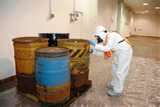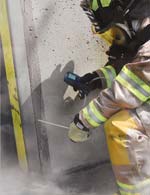"This facility is not only the first oil and gas field operations for ConocoPhillips that has exceeded OSHA's VPP minimum standards, but the company has not had an OSHA recordable injury since 2005," said Dean McDaniel, OSHA's regional administrator in Dallas, Texas.
"[T]hese settlements call for tough new controls and innovative technologies to cut down on harmful air emissions that threaten the health of millions of Americans," said Cynthia Giles, assistant administrator for EPA's Office of Enforcement and Compliance Assurance.

"This was a serious accident which claimed the lives of four workers, injured scores of others, and resulted in hundreds of job losses," said CSB Chairman John Bresland. "The goal of the CSB investigation is to recommend measures that will help prevent other devastating accidents during gas purging operations."
The refinery "did not ensure adequate maintenance and oversight of its process safety equipment, exposing workers to the release of toxic chemicals and posing a danger to not only the company's employees but to the community, as well," said Dean McDaniel, OSHA's regional administrator in Dallas.
Requirements for exposure limits, exposure monitoring and determination, protective work clothing and equipment, medical surveillance, communication of hexavalent chromium hazards, and recordkeeping are described.
The company offers in vitro diagnostic kits, and analyte-specific, general purpose, and research-use-only reagents for nucleic acid analysis. EPA said the company failed to obtain a hazardous waste storage license, among other things.

An IOM committee's report outlines a national strategy for preventing and controlling Hepatitis B and C, calling them "important public health problems" and noting 5.3 million Americans have the diseases in chronic form. They are more common in this country than HIV/AIDS, but awareness is low.
"Unfortunately, this incident was a classic example of a multiple-fatality event where would-be rescuers are themselves overcome in their attempt to save the initial victim," said Kay Gee, OSHA's area director for Queens, Manhattan, and Brooklyn.
The number of falsified emissions reports varied by defendant, with some defendants having falsified approximately 250 records, while others falsified more than double that number, for anywhere from $10 to $100 over and above the usual emissions testing fee, DOJ said.
According to the society, recent studies indicate that approximately 40 percent of work-related fatalities are design related.
The colorless, odorless, tasteless gas is the second leading cause of lung cancer in the United States, behind cigarette smoking, the agency notes.
At the request of the Food and Drug Administration, U.S. Marshals have seized bulk restaurant food product at Won Feng Trading Company, a food processor and warehouse in Nashville, Tenn. The products are adulterated under the Federal Food, Drug, and Cosmetic Act because they have been held under unsanitary conditions whereby they may have become contaminated with filth. The act uses the term "insanitary" to describe such conditions.
"Our inspections, and a worker fatality at the Blakely (Ga.) plant, show the need for management to get serious about the safety and health of its employees," said Robert Vazzi, OSHA's area director in Savannah, Ga.

Endocrine disruptors may be addressed this year, but comprehensive action on combined chemicals as a whole probably is two years away, according to the EU.

NIOSH Director Dr. John Howard has informed OSHA's assistant secretary that NIOSH and NIEHS research on the alternative butter flavoring 2,3-pentanedione "suggests that, in rats, 2,3-pentanedione causes airway epithelial damage similar to that produced by diacetyl."
As a result of using data collected from millions of cars and trucks gathered since MOBILE6.2 was released in 2004, MOVES2010 provides increased accuracy in emissions inventory results, the agency said.
The agency has developed a new Web-based tool and interactive map that allows the public to get detailed information by location about the enforcement actions taken at approximately 4,600 facilities.
"This will be the first time code officials, owners, and designers will have an integrated regulatory framework to put into practice that meets the goal of greening the construction and design of new and existing buildings," said Code Council CEO Richard P. Weiland.

The clock is ticking. Companies will have three years from promulgation to come into compliance with the final rule and two years to implement training requirements.

Are user seal checks necessary to ensure protection? And, if so, when should they be performed? A white paper prepared by the American Industrial Hygiene Association's Respiratory Protection Committee asks these and several other questions to resolve important issues.